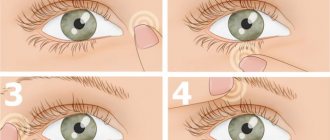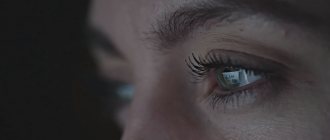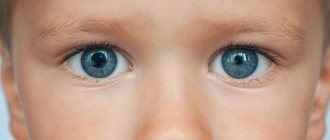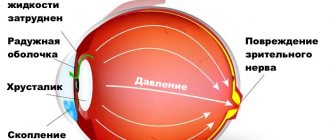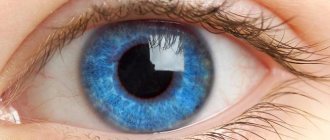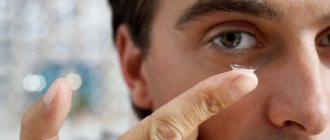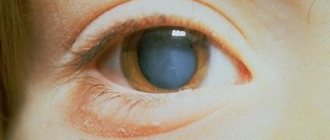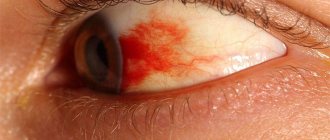The appearance of pain under the upper eyelid is often ignored. Due to the lack of treatment, symptoms intensify, discomfort when pressing, swelling, redness and other signs of pathology appear. The reasons for this condition may vary. It can be provoked by fungal, viral, bacteriological infections that cause inflammation of the periocular tissues and the formation of ulcers.
Causes
Soreness in the eye under the upper eyelid can occur:
- as a result of injury, for example after a blow;
- from insomnia;
- with decreased immunity;
- due to chronic fatigue;
- in case of nervous shock;
- if you have a cold;
- due to allergies;
- with improper skin care.
In addition to external factors, there are a number of diseases in which the upper eyelid hurts, with redness and inflammation. For example:
- acute respiratory infections;
- sinusitis;
- erosion of the ocular mucosa;
- inflammation of the iris;
- glaucoma;
- inflammation of the eye mucosa;
- dacryocystitis;
- chalazion;
- barley.
Barley (boil), that is, inflammation of the sebaceous glands, is the result of a lack of immunity or a cold. If there is a boil on the upper eyelid, it usually hurts for a person to blink. If you do not seek medical help in a timely manner, further development of the pathology is possible. A stye is often confused with a chalazion and is also called a cold stye. Chalazion is a blockage of the sebaceous gland, and treatment is often surgical.
The area under the upper eyelid may also hurt due to increased intraocular pressure. This is a common symptom of all office workers, since they spend several hours in a row in front of a computer monitor, experiencing severe stress on the blood vessels of the eyes. Increased pressure in the eyeball can trigger an attack of glaucoma.
Another diagnosis that causes pain in the eye under the upper eyelid is squamous cell skin cancer. Less than 25% of eyelid neoplasms are oncological.
What kind of pain can there be under the upper eyelid?
If the eye under the upper eyelid hurts so much that it hurts to press, the following symptoms of pathology are possible:
- discharge of pus;
- pain when pressing;
- redness and swelling;
- heat.
Due to trauma, pressure on the upper eyelid is accompanied by discomfort, swelling and increased tear production. If there is a stye (boil) under the upper eyelid, the eye hurts when blinking, the inflamed eyelid swells and turns red.
An abscess, that is, purulent-necrotic inflammation of tissue, is provoked by bacteria. With the disease, it’s not just the eye that hurts under the upper eyelid. The diagnosis is accompanied by the following symptoms: severe swelling, drooping eyelid, redness. The disease can be life-threatening, so you should see a doctor immediately.
There is another serious illness, phlegmon - inflammation of the tissue, which has no specific boundaries. There are different localizations, depending on which the symptoms differ:
- eyelid – the eye hurts a lot;
- lacrimal sac - a purulent formation appears;
- eye sockets - the eyeball becomes motionless, the temperature rises, and vision decreases.
Infection with phlegmon often penetrates the blood, affecting surrounding tissues or even the membrane of the brain.
With conjunctivitis, the eye under the upper eyelid hurts as if something had hit it. With the bacterial form, pus is released, and with the viral form, the eyeball becomes very red.
Do not forget that the listed diseases and even a slight injury to the eye can cause vision problems. To avoid such consequences, you need to undergo a complete diagnosis.
Types of disease
The types of ptosis include:
- unilateral (appears in one eye) and bilateral (in both eyes);
- complete (the upper eyelid completely covers the eye) or incomplete (closes only partially);
- congenital and acquired (depending on the cause of occurrence).
The severity of ptosis is determined by how much the eyelid droops:
- 1st degree is determined when the upper eyelid covers the pupil from above by 1/3,
- 2nd degree - when the upper eyelid is lowered onto the pupil by 2/3,
- 3rd degree - when the upper eyelid almost completely hides the pupil.
The degree of visual impairment depends on the severity of ptosis: from a slight decrease in vision to its complete loss.
What can it be confused with?
The following pathologies of the visual organs can be mistakenly mistaken for ptosis:
- dermatochalasis, due to which excess skin of the upper eyelids is the cause of pseudoptosis or ordinary ptosis;
- ipsilateral hypotrophy, which is expressed in drooping of the upper eyelid following the eyeball. If a person fixes his gaze with the hypotrophied eye, while covering the healthy eye, pseudoptosis will disappear;
- the eyelids are poorly supported by the eyeball due to a decrease in the volume of the orbital contents, which is typical for patients with false eyes, microphthalmos, phthisis of the eyeball and enophthalmos;
- contralateral eyelid retraction, which can be determined by comparing the levels of the upper eyelids. It should be taken into account that covering the cornea with the upper eyelid by two millimeters is the norm;
- brow ptosis, caused by excess skin in the brow area, which can occur with facial nerve palsy. This pathology can be determined by raising the eyebrow using your fingers.
Survey
In case of swelling of the upper eyelid, an examination is carried out by an ophthalmologist. It defines:
- location of the edema (on one or both sides);
- localization of symptoms;
- Does the eye hurt when pressing and blinking?
- level of vision;
- the degree of heating of the affected skin of the eyelid (by touch).
When making a diagnosis, the doctor relies mainly on the clinical picture. Sometimes, in case of injury or suspected blood clots in the vessels, the patient needs to undergo laboratory tests:
- general blood and urine analysis;
- checking blood and urine glucose levels;
- smear cytology;
- test for demodicosis (parasitic disease).
If necessary, biomicroscopy of the eye and a fluorescein test (by injecting a fluorescein solution) are performed. When the eye under the eyelid hurts due to injury, an x-ray of the damaged area is required.
To make a diagnosis related to a defect in the upper eyelid, a specialist evaluates the condition of the fold, especially in older people for whom drooping eyelids are normal. For a correct diagnosis, the ophthalmologist finds out how and in what area the eye hurts, finds out whether the discomfort increases during physical activity, moving and closing the eyes, moving the body, and blinking.
In case of specific disorders, you need to additionally contact a surgeon, infectious disease specialist, venereologist, phthisiatrician, or allergist.
Diagnosis of the disease
When identifying a drooping eyelid, which is noticeable even with the naked eye, doctors need to determine the cause of the disease in order to prescribe treatment.
The ophthalmologist measures the height of the eyelid, studies the symmetry of the position of the eyes, eye movements, and the strength of the muscle that should raise the eyelid. When diagnosing, be sure to pay attention to the possible presence of amblyopia and strabismus.
In those patients who have acquired ptosis during life, the muscles that lift the eyelid are quite elastic and elastic, so they can completely close the eye when their gaze is lowered.
With congenital ptosis, the eye cannot close completely even with the gaze lowered to the maximum, and the upper eyelid makes movements of very small amplitude. This often helps diagnose the cause of the disease.
The importance of determining the cause of ptosis is that with congenital and acquired ptosis, different parts of the visual analyzer suffer (with congenital ptosis, the muscle that lifts the eyelid itself, and with acquired ptosis, its aponeurosis). Accordingly, the operation will be performed on different parts of the eyelid.
Notes from an ophthalmologist on the treatment of retinal angiopathy. You will learn about effective, comprehensive treatment for this disease.
The article (link) describes methods for solving the problem of a twitching eye.
What to do if your eyes itch? The answer is not so simple -
What to do for eye pain
The doctor prescribes the correct treatment for the disease after making a diagnosis and finding out its causes.
- For example, if the injury site hurts, you will need cold lotions or vasoconstrictors.
- When the eye is sore and swollen due to an infection, it can be relieved with antimicrobial drops and ointments. Eye inflammation is effectively relieved by:
- drops: “Vitabact”, “L-Optic”, “Uniflox”, “Tobrex”, “Chloramphenicol”;
- ointments: tetracycline, erythromycin or hydrocortisone.
- Barley is an inflammatory disease. Pus can penetrate the sebaceous glands, which leads to the formation of new boils on the upper eyelid, which begin to hurt. For barley, you can help at home in the form of lotions with infusions of calendula and aloe. The juice of these plants is dissolved in water in a ratio of 1:10. It is also advisable to increase the daily intake of vitamin C. For boils, folk remedies are usually not enough. Then the local ointments already listed above, Tsiprolet and Albucid drops, are prescribed.
- The abscess is treated surgically. Its autopsy is carried out in a hospital for about 10 minutes, after which the wound is washed with an antiseptic solution and an antibacterial drug. Then the patient is prescribed a course of antibiotics (Ampiox, Augmentin, Lincomycin) in the form of tablets or injections.
- For conjunctivitis, it is necessary to wash the eyes with disinfecting solutions containing furatsilin, potassium permanganate, dimexide, and oxytocin. And instill the drops that the doctor prescribes. For each form of the disease, its own drugs are prescribed.
- If the eye hurts due to erysipelas (acute inflammation, simply erysipelas), it is treated with classical methods: quartz treatment - treating the affected area with illumination of a quartz lamp and autohemotherapy - infusion of the patient’s own venous blood.
Any discomfort in the area of the affected eyelid is a reason to refuse decorative cosmetics.
Treatment
Therapy will depend on the diagnosis. In case of injury, cold lotions and special drops and ointments are usually used to eliminate painful sensations.
Inflammatory processes in the tissues of the eyelids are usually eliminated with antibacterial and antiviral drugs. These can be drops and ointments for the eyes (Vitabact, Tobrex, tetracycline ointment).
Self-treatment of a boil is strictly contraindicated! This requires examination by a specialist and following his recommendations. In some cases, it is necessary to remove the pustular contents surgically, for which, under local anesthesia, the skin of the eyelid is cut and the purulent masses are removed.
For colds, general treatment is usually prescribed - antibiotics or antiviral drugs orally, drinking plenty of fluids, bed rest and taking multivitamins. As you recover, unpleasant symptoms in the eyelid area should go away on their own.
The only true treatment for allergies is taking antihistamines. The doctor may use a combination of oral and local medications. If an allergy appears for the first time, then it is advisable to find the source of the individual reaction (allergen) in order to subsequently try to avoid contact with it to prevent relapse. The most difficult situation is with hay fever. Such patients not only have to take antihistamines throughout the flowering period (from April to September), but also follow a special diet, as well as adhere to other recommendations to alleviate the condition.
In case of insect bites, only time will save you. You can reduce unpleasant pain with products with a cooling effect, as well as local antihistamines (Fenistil drops or cream), which relieve itching and burning.
